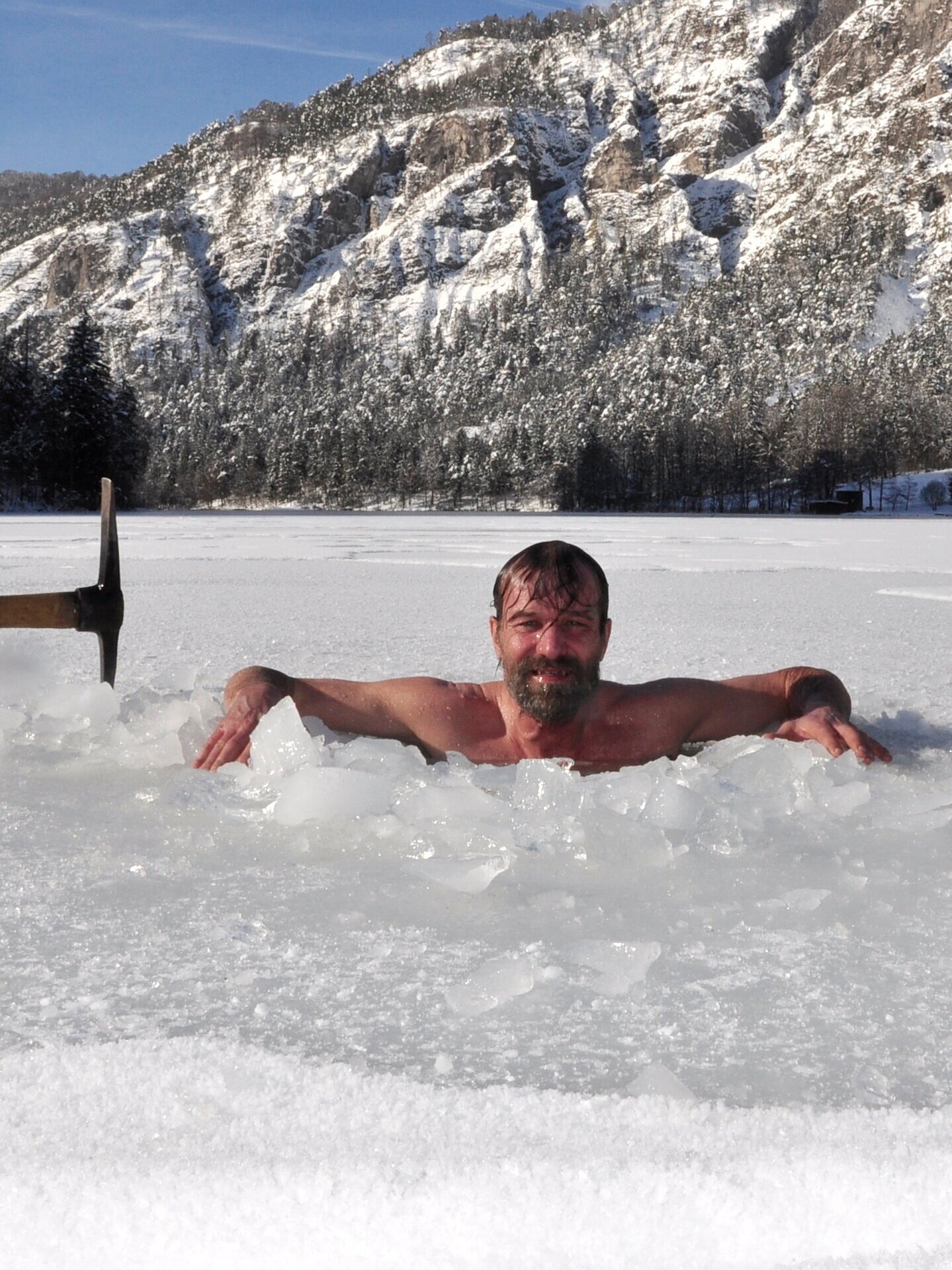Wim Hof Method Explained.
If you find this article valuable and want to go deeper and learn more, join The STLL Membership,
an online self-development platform providing practical, on-demand tools and lessons for living well.
Who is Wim Hof?
Wim Hof is a Dutch living legend. A charming, eccentric and entirely authentic revolutionary, commonly known as “The Iceman”. He has set 26 different World Records, including the longest swim under ice, the fastest half-marathon barefoot above the Arctic Circle and the longest time submerged in full-body contact with ice: 1 hour, 53 minutes, 2 seconds. In 2007 he climbed to the summit of Mt. Everest wearing nothing but shoes and shorts. He also ran a full marathon through the scorching Namibian Desert without a single drop of water. Today, he is the personification of mental strength and resilience. It was in 1995 when Wim’s wife and the mother of their four children tragically took her own life, Wim has expressed that his despair over this loss became the catalyse and coping mechanism through which he developed the techniques now known as the Wim Hof Method (WHM). With the committed daily practice of these methods, he has mastered control of his breathing, heart rate, blood circulation and body temperature, which has resulted in enormous and scientifically robust health benefits.
Wim’s motto is: “What I am capable of, everybody can learn”.
And by now, you’ve probably heard the extensive list of benefits people are experiencing from the WHM:
Improved health
Strengthened immune system
Reduced inflammation
Increased vagal tone
Reduced stress
Balanced hormones
Elevated mood
Increased energy
Better sleep
Heightened focus and determination
Greater tolerance
Faster recovery
Enhanced creativity
But what exactly is it and how does it work?
What is the Wim Hof Method?
The WHM is surprisingly simple for the magnitude of its benefits.
Built on just three pillars: breathing, cold therapy and commitment.
It is the combination of these components that appears to greatly impact both physiology and mental capacity, as shown by several scientific studies.
How does it work?
In an attempt to capture it simply…
All three components are important and interlinked:
The breathing technique helps to get your body into the state required to gain access to your autonomic nervous system and to resist the cold.
The cold is used to boost the physiological effects.
Commitment, focus and concentration (or Wim’s version of meditation) create a strong mindset and a strong body over time.
Breathing:
The autonomic nervous system regulates functions such as breathing, internal organs, digestion, the dilation and contraction of the blood vessels and the heartbeat. Until Wim, medical opinion claimed no influence could be exerted over this system. Inhaling oxygen was understood simply as an unconscious process.
Every day, we inhale and exhale on average 20,000 times to make sure we absorb sufficient oxygen, the ultimate source of life. Wim discovered that breathing is the easiest and most instrumental part of the autonomic nervous system to control and navigate. In fact, the way we breathe strongly affects the chemical and physiological activities in our bodies. The WHM breathing technique is first and foremost premised on inhaling deeply and exhaling, without any use of force, to a point where a residual of air remains in the lungs, it is a type of controlled hyperventilation with the use of breath retention at certain points during the process.
It is always advised to learn this technique with a trained WHM instructor.
When utilising the systematic breathing exercises you consume a lot of oxygen and the concentration of CO2 in your blood lessens almost immediately. The pH-value in the blood increases (making the blood more alkaline) whereas the acidity lessens. On average the pH-value in the body is 7.4. By exerting the breathing techniques, this becomes significantly higher. During the E-coli experiment (which is a truly groundbreaking published scientific study explained in the video below) values were measured up to 7.75.
I cannot stress enough how biologically significant that figure is.
This study is nothing short of extraordinary, particularly when you consider that for decades on end the standpoint in medical discourse had been that the autonomic nervous system cannot be influenced. The blood results, however, unequivocally show that the autonomic nervous system, the endocrine system and immune system can be regulated. Until this study, this had never been proven scientifically. Another remarkable finding is that the immune system can be improved even after a relatively short training session. Tests showed that even “normal” people are more than capable of channelling their immune system, producing far less inflammatory proteins.
Chronic systemic inflammation is associated with many illnesses, depression and anxiety.
Cold Therapy:
In our society, we are used to turning up the heat or putting on an extra layer as it gets colder. We are used to comfort. However, in the WHM the cold is an essential force involved in accessing the autonomic nervous system (and the associated immune system). Continuing to expand on the E-coli experiment, it appeared that the amount of inflammatory protein in Wim Hof's bloodstream during exposure to ice (with the aid of the breathing/concentration technique) was significantly less than when the breathing/concentration technique was employed on its own.
Exposure to ice, with breathwork, resulted in no inflammatory proteins at all!
Even more surprisingly, the results also revealed that white blood cells showed a continued lower production of pro-inflammatory cytokines, even after 6 days. This was a very important finding for healthspan, as low levels of pro-inflammatory cytokines were the only universal biomarkers found in centenarians (a person who has reached the age of 100 years) and supercentenarians, as seen in the Blue Zones Study - a global study on health and longevity.
The next question is how Wim remains resistant to long-term exposure to the cold when shock and hypothermia in ice water can take place in just 3 minutes?
During the 80 minutes in which he was exposed to ice, his body temperature remained at a constant 37 degrees (hypothermia begins at 35 degrees), his heartbeat remained low and his blood pressure normal. How is this physically possible? A study by Hopman et al. (2010) showed that Wim’s metabolic rate increased by 300% during exposure to ice. This increased metabolic rate increased the heat production of his body. According to Hopman, "Hof can turn up his heating system to three times the normal rate. He also does not shake and shiver, which is normally what the body would do to get warm.”
This is again achieved through the combination of breathing/concentration and cold, the subsequent uncoupling of particular receptors within the body and the rapid burning of brown fat. The mechanics of this are explained in full in this short podcast extract with Dr Rhonda Patrick, an American biochemist and Dr Pierre Capel, PhD, professor emeritus in experimental immunology at the Utrecht University in the Netherlands.
These are two fantastic minds to listen to discuss the science behind this impressive process.
References
Buettner, D., & Skemp, S. (2016). Blue Zones: Lessons From the World's Longest Lived. Retrieved from https://www.ncbi.nlm.nih.gov/pmc/articles/PMC6125071/
Groothuis, J.T., Eijsvogels, T,M., Scholten, R. R.,Thijssen, D. H.,& Hopman, M,T. (2010). Can meditation influence the autonomic nervous system? A case report of a man immersed in crushed ice for 80 minutes.
Kox, M., Stoffels, M., Smeekens, S. P., Alfen, N, van., Gomes, M.,Eijsvogels, T. M. H., Hopman, M. T. E, Hoeven, J. G, van der., Netea, M. G.,& Pickkers, P.(2012). The influence of concentration/meditation on autonomic nervous system activity and the innate immune response a case study. Psychosomatic Medicine, 74, 489-449.
Kox, M., van Eijk, L. T., Zwaag, J., van den Wildenberg, J., Sweep, F. C. G. J., van der Hoeven, J. G., & Pickkers, P. (2014). Voluntary activation of the sympathetic nervous system and attenuation of the innate immune response in humans. Retrieved from https://www.ncbi.nlm.nih.gov/pmc/articles/PMC4034215/
Nedergaard, J., Bengtsson, T., & Cannon, B. (2007). Unexpected evidence for active brown adipose tissue in adult humans. American Journal of Physiology – Endocrinology and Metabolism, 293, 444-452.
Sramek, P., Simeckova, M., Jansky, L., Savlikova, J.,& Vybiral, S. (2000). Human physiological responses to immersion into water of different temperatures. European Journal of Applied Physiology, 81, 436-442.
“The Science Behind The Wim Hof Method.” The Science Behind The Wim Hof Method. Retrieved from www.wimhofmethod.com/science.
Wu, S. D., & Lo, P. C. (2008). Inward-attention meditation increases parasympathetic activity: a study based on heart rate variability. Biomedical Research, 29, 245-250.


